By Doug Winter – RareGoldCoins.com ……
CoinWeek Content Partner ……
Imagine, if you will, that the coin market is a sushi bar. You look in the cases and you see the familiar fish: salmon, albacore, mackerel, and regular tuna. Off in the corner, in a special case, there is the prized (and pricey) fatty tuna (or Toro) wrapped in special paper and brought out for special customers only. That fish, in our Numismatic Sushi Bar, is Proof Gold: rare, unusual, and very expensive.
* * *
Unquestionable Proof gold coins from the United States Mint exist as far back as 1820 but, with a small number of exceptions, most collectors will never see–let alone own–a Proof gold coin dated prior to the years immediately before the Civil War. Proof gold was generally struck in very limited quantities (usually fewer than 100 pieces) and even issues which are relatively available are still rare in comparison to business strikes from this era.

1867 $10.00 NGC PR64 UCAM STAR CAC. All images courtesy Douglas Winter Numismatics
The issues struck prior to 1908 were made in a brilliant finish. They were struck with multiple blows of the dies on polished planchets and with far greater care than coins made for general circulation. They were made specifically for collectors and were generally better preserved than coins made for circulation; this is why most Proofs are found in the PR63 to PR65 range.
Proofs struck from 1908 through 1915 were made in a Matte finish. These coins have a sandblast appearance and they can be an acquired taste as they lack the “flash” shown by their brilliant counterparts.
It takes a lot of money to form a specialized collection of Proof gold, and many collectors are content to dabble by adding a coin here and a coin there. But this is such a fascinating area to collect that I feel it is worthwhile to discuss collecting Proof gold in detail. In this article, we will look at the obvious–and the not-so-obvious–ways in which these exciting coins can be collected.
Specializing by Design Type
Probably the most obvious way to collect Proof gold is by design type. This set consists of nine coins, as follows:
- Type Three Gold Dollar (1856-1889)
- Liberty Head Quarter Eagle (1859-1907; dates prior to 1859 are extremely rare)
- Indian Head Quarter Eagle (1908-1915)
- Three Dollar Gold (1854-1889)
- Liberty Head With Motto Half Eagle (1866-1907)
- Indian Head Half Eagle (1908-1915)
- Liberty Head With Motto Eagle (1866-1907)
- Type Three Liberty Head Double Eagle (1877-1907)
- St. Gaudens Double Eagle (1908-1915)
These nine types are the most readily available designs of Proof gold. The most common is the Type Three Gold Dollar (nice examples can be purchased for under $10,000 USD), while the most expensive types are the two double eagles (nice examples start at around $40,000-50,000).
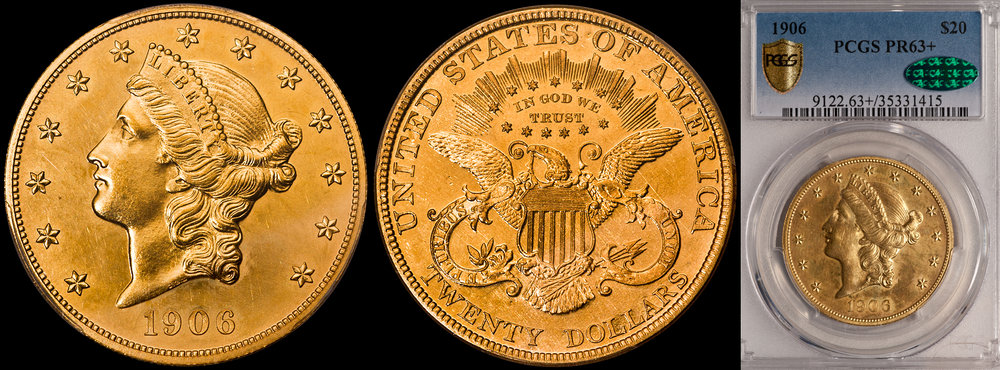
1906 $20.00 PCGS PR63+ CAC
If you want to collect a design set, I would suggest that you be fairly consistent with grade. In other words, don’t fill the double eagle slots with impaired PR58 coins while filling the more common gold dollar and quarter eagle slots with PR64 pieces. I would also suggest you search for “slightly better” to “better” dates for each type. By this, I mean instead of purchasing a reasonably common 1905 quarter eagle, spend a little more money on a lower mintage date from the 1880s or the 1890s.
A nice quality PR63 to PR65 basic nine-coin set with mostly better (but not ultra-rare) dates should cost in the area of $300,000-350,000. A Gem set with all coins grading PR65 and finer should cost $500,000-600,000.
This set can be expanded to 15 coins, but not without considerable effort and expense by adding a Type Two Gold Dollar (1854-1855), Classic Head Quarter Eagle and Half Eagle (1834-1838), No Motto Liberty Head Half Eagle and Eagle (1860-1865; dates prior to 1860 are exceedingly rare), and Type Two Double Eagle (1866-1876). These six coins can easily add $1 million to the price of a Gem set.
Specializing by Denomination
If you are a deep-pocketed collector seeking a real challenge, a specialized collection of Proof gold represents a very serious and involved focus. Due to price and rarity considerations, the Liberty Head eagle and double eagle series are next to impossible, although it should be noted that a few advanced collectors are currently working on in-depth date runs in these two denominations.
The most completable denominations are the Type Three gold dollar and the Three Dollar gold piece, with the amended Liberty Head quarter eagle set (1859-1907) also a possibility. Due to their much shorter duration and their higher mintages (and survival rates), the three Matte Proof denominations (half eagle, eagle, and double eagle) are realistic targets for collectors who favor completeness and relatively high grades.
Gold Dollars
There were 34 different Proof gold dollars made between 1856 and 1889. The issues made prior to 1881 are all rare but obtainable in PR64 and higher grades. The key issues are the 1856-1858 (all were made in very limited quantity and have around 10 or so survivors known today) and the low-mintage 1873, 1874, 1875, 1877, and 1878 (all were struck in quantities of 20 to 25 and have around 10 to 15 examples known today).
The advantages of choosing to specialize in Proof gold dollars is that this set can actually be completed, and it can be accomplished for around $1,000,000 to $1,500,000 for a very high-end set; in other words, this set isn’t “cheap” but it is comparatively affordable compared to the other denominations we will look at.
The only disadvantage I can think of when it comes to gold dollars is their relatively small size. $30,000-40,000 and up is a lot of money to pay for a Gem example of a very small coin and this is clearly not going to appeal to certain collectors. Other people, myself included, really like gold dollars and find their minimal size to be a big part of their charm.
Liberty Head Quarter Eagles
Proof Liberty Head quarter eagles were struck in the 1840s and ’50s, but a more realistic goal for a date set would be to begin with the 1860 and continue through until the end of this type in 1907.
All of the dates struck prior to 1880 are rare to very rare, with many showing original mintages in the 20-30 coin range. Gems (PR65 and finer) tend to be expensive but in my opinion, they are good value at current levels given their unimpeachable rarity level. Some of these dates are actually somewhat affordable in the PR63 to PR64 range, although they are not often available at this level.
This set is completable, and a nice quality set of 48 dates from 1860 through 1907 would likely cost in the $1,500,000-$1,750,000+ range.
I can’t think of a single disadvantage when it comes to the decision to specialize in Proof quarter eagles. They are a bit on the small side, but they offer uncommonly good value when it comes to rarity and price within the Proof Gold arena.
Three Dollar Gold
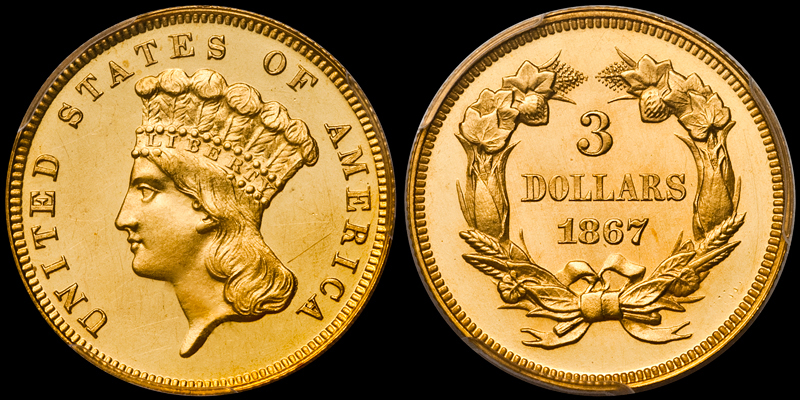
1867 $3.00 PCGS PR63DCAM CAC
The third and final set that might interest the specialist is the Three Dollar series, of which 37 different issues were made between 1854 and 1889 (note: two different varieties of 1873 exist, Open 3 and Closed 3.)
This is the most challenging of the three denominations. The 1854-1859 dates are all very rare, with the 1855 being the rarest of these six issues; no Proof 1855 has traded at auction since 2003. A number of dates from the 1860s and ’70s have proven to be very rare and they trade once every three to five years (1861, 1866, 1868, 1870, and 1874) in PR64 and higher grades.
The key issue is the Proof-only 1875, of which only 20 were originally struck (it is very likely that another 15 or 20 were restruck later in the year). This is an expensive issue–likely the most expensive in the set for most collectors–but it is far from the rarest. That said, you can expect to spend $250,000+ for a nice Proof 1875 three.
A complete set of Proof Three Dollar Gold pieces is expensive. I’d suggest a minimum outlay of around $2.5 to $3.0 million. But what an accomplishment this would be!
Specializing in Proof-Only Dates or Ultra-Rare Dates
There are a small number of 19th-century gold issues that were produced only in a Proof format. These are very desirable and would make an extremely interesting specialized set.
Here is a list of Proof-only dates along with some pertinent comments:
1863 Quarter Eagle: A total of 30 were struck. This is the most expensive collectible date in the Proof quarter eagle series although it is far from being the rarest. Interestingly, there are more impaired examples of this date than for other quarter eagles of this era – likely the result of this being regarded as a rarity ever since it was made.
1873 Open 3 Three Dollars: This is a mysterious issue with an unknown original mintage (thought to be around 25 coins). Proofs of this year exist both as the Open 3 and Closed 3 varieties.
1875 and 1876 Three Dollars: There were 20 struck (plus restrikes) for the 1875, and 45 (plus restrikes) for the 1876. The 1875 is the most highly regarded Proof of the series, while the 1876 is regarded by some experts as being overrated as it is far more available than other Proofs from the 1870s at a significantly higher price.
1887 Half Eagle: A total of 87 were struck. This date sells for a significant premium over other dates from the 1880s but it is more available. Given the fact that Philadelphia half eagles are not widely collected by date, it is not a stretch to state that this is an overvalued date. But it has been recognized as a rarity for well over a decade.
1883, 1884, and 1887 Double Eagles: The mintage figures for these three issues are 92, 71 and 121, respectively. It is interesting to note that while all three of these dates are expensive, the premiums versus rare Proofs of this type which are not Proof-only seem more realistic than for the issues listed above. This is likely due to the fact that Type Three double eagles are actually collected by date and very rare issues like the 1881, 1882, 1885, and 1886 are six-figure coins in Uncirculated.
There is another class of Proof gold that incorporates dates that are very rare due to low mintage figures as business strikes. As a result, Proofs from these years sell for strong premiums. Some examples of these are as follows:
1864 and 1865 quarter eagles: The former has a mintage of 50 Proofs while the latter has a mintage of 25. Both are exceedingly rare as Uncirculated business strikes, which puts date pressure on Proofs.
1875 quarter eagle: This is a magical year for gold coins as the Philadelphia dollar, quarter eagle, three dollar, five dollar, and 10 dollar are all rare low-mintage issues. Only 400 quarter eagles were made for circulation and although this is only a moderately rare date, Proofs command a large premium. This can be partially justified by the rarity of these coins; only 20 were made.
1873 Closed 3 three dollars: Business strikes are reasonably available for the Closed 3 despite a mintage of just 600-900 coins, but Proofs are extremely rare with as few as a half dozen known. A few unusual bulged die pieces exist with convex obverses.
1875 half eagle: Only 200 business strikes were made and fewer than 10 exist in all grades with none in Uncirculated. Proofs are very rare in their own right with an original mintage of 20.
1875 eagle: This is an even rarer coin than the half eagle of this date, with seven or eight business strikes known from a mintage of 100. Proofs are very rare with an original mintage of just 20.
1881, 1882, 1885, and 1886 double eagles: As mentioned above, these are rare, low-mintage issues with six-figure valuations as choice business strikes. Proofs are rare but actually command less of a premium than one might expect.
Specializing in Proofs of One Certain Year
This collecting technique would involve building a Proof Set of all gold issues produced in a certain year. Ideally, this would include six denominations: gold dollar through double eagle.
Since the gold dollar and three dollar denominations were discontinued in 1889, the set would obviously have to be dated no later than this year. And given the rarity of Type Two double eagles (1866-1876) in Proof, it would make sense to stick with a Type Three double eagle (1877-1889 in this case). Except for one big problem: as I stated above, the 1883, 1884, and 1887 are expensive Proof-only dates. This leaves us with 10 realistic dates: 1877-1882, 1885-1886, 1888 and 1889.

1888 $2.50 PCGS PR67DCAM CAC
The two dates which would make the most sense are the 1888 and the 1889. With both dates, the coins get scarcer (and more expensive) as the size increases. Proof 1888 and 1889 eagles and double eagles are all rare to very rare, but they are not impossible targets.
As original sets of gold proofs from this era are essentially unavailable, the collector needs to ask himself if assembling a “put-together” set is worth the effort and expense. In my experience, the answer is “yes”, but with the following caveats.
A put-together gold proof set is not likely to carry a set premium unless it checks the following boxes:
- The coins must have a reasonably consistent appearance. It helps if all are Cameo or Deep Cameo and it helps if all are bright or all are hazy, original.
- The coins must grade somewhat consistently. The set should have all coins graded within a point or two. It makes no sense to, say, have a PR67 CAM gold dollar mated with a PR58 double eagle.
- The coins all need to be graded by one service. If there are six coins and two are graded by NGC while the others are graded by PCGS, it’s obvious what the first reaction is going to be when potential buyers view the set.
- The coins should have consecutive serial numbers. This is more psychological than anything else.
How Far Will My Dollars Go?
As I mentioned above, Proof gold is expensive. But for well-heeled collectors, it is not an impossibility to receive a decent amount of bang for your buck.
Here is a list of what you can buy at four different price points. Your mileage may vary based on availability, market conditions, etc.
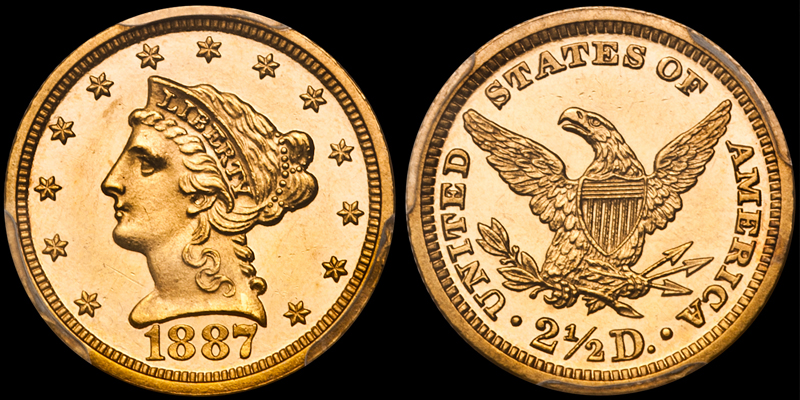
1887 $2.50 PCGS PR63CAM CAC
$5,000-10,000
At the lower point of this range, you are limited to decent quality (PR63 to PR64) common date gold dollars and similar grade common date Liberty Head quarter eagles. At the higher point of this range, your options are still mainly gold dollars and Liberty Head quarter eagles but you can now focus on either higher grade (PR65) common date gold dollars from the 1880s and common date Liberty Head quarter eagles in higher grades (PR64). There is also the possibility at the $10,000 price point you can locate a PR63 example of a rarer gold dollar from the 1870s or a quarter eagle from the 1880s.
$15,000-25,000
At this range, there are some really interesting coins available.
If you choose to stick with smaller denomination issues, you can find truly rare gold dollars and quarter eagles for around $20,000. As an example, I recently sold a very rare 1862 PCGS/CAC PR64 DCAM gold dollar (one of around 12-15 known in total) for a bit under $20,000. This price point also allows the collector to purchase interesting PR64 Three Dollar gold pieces from the 1880s. It is harder to purchase larger-sized coins for $25,000, but this figure allows you to dabble in the half eagle and eagle denominations; albeit in the PR63 to PR64 grade range.
Another interesting possibility at the $25,000 level is a PR65 Indian Head quarter eagle with all the bells and whistles (i.e. PCGS/CAC). A PR64 Indian Head half eagle might also be a possibility, albeit minus a CAC sticker.
$30,000-50,000
At this range, you will be able to purchase many rare and interesting Proof gold coins. In the lower denominations (G$1 through $3), there are many interesting issues available including Gem examples of issues with mintages of less than 35.
Half eagles become far more available at this price and there are options available, including Gems (PR65) from the 1880s and ’90s and borderline gems (PR64) from the 1870s.
Eagles that might be available include near Gems from the early 1900s and as far back as the 1880s.
Unfortunately, there are not a lot of interesting double eagles available, even at the upper level of this range. A common date (1900-1907) Proof Liberty Head double eagle in the PR63 to PR64 range should be buyable in the $35,000-45,000; albeit without a CAC sticker.
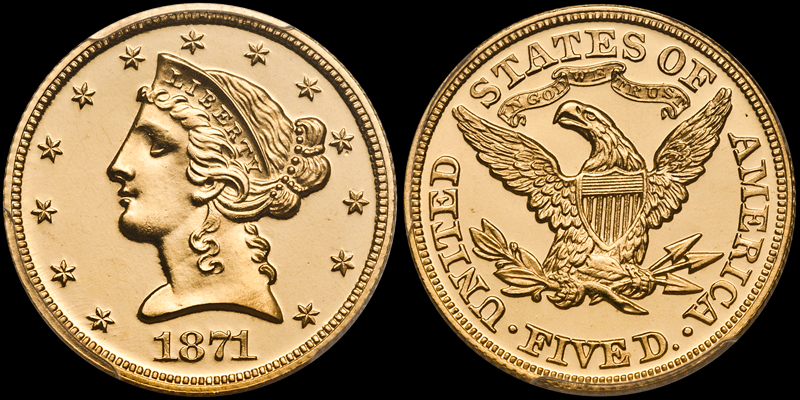
1871 $5.00 PCGS PR65+ CAMEO CAC
$60,000-80,000
If you are fortunate enough to have a big budget, there are all sorts of museum-quality Proof gold coins that you can attempt to add to your holdings. In the realm of smaller denominations, I would tend to shy away from super-grade gold dollars and quarter eagles, although I would be an eager buyer of a great $75,000 Gem Proof quarter eagle if it were the finest known example of a truly rare date. I feel that the greatest value in this price range is rare date half eagles from the 1860s and ’70s. In September 2014, I bought a PCGS/CAC PR65 1871 for $70,500. This coin was likely the finest of only eight or nine known, and it was pedigreed all the way back to the 1880s.
Some very special Indian Head Proof gold might work at this price point. How about a PCGS/CAC PR66 half eagle or a PCGS/CAC PR66 eagle?
$100,000+
Now here’s where the real fun begins.
Six-figure selections include famous Proof-only rarities such as the 1863 quarter eagle, or the 1875 three dollar or very rare dates like the 1875 half eagle and eagle.
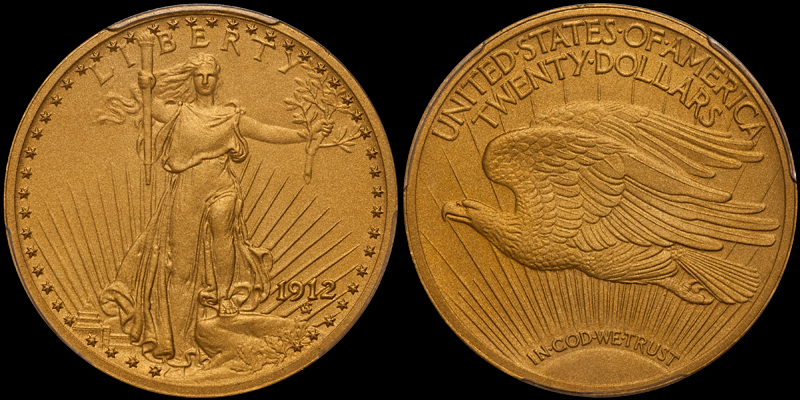
1912 $20.00 PCGS PR67
If I had a macho budget for Proof gold, I’d focus on “macho” coins like Type Two Liberty Head double eagles (how about a Gem Proof 1876 at around $200,000), or an awe-inspiring Gem Proof St. Gaudens double eagle (any date but 1908, please…), such as a 1911 in PCGS PR67. I’d make certain that my six-figure Proofs were PCGS/CAC, and I’d focus more on rare dates than average rarity in exceptional grade.
A Few Closing Thoughts
It is difficult to gauge the current market for Proof gold in early 2019. Clearly, there is strong demand and, equally clearly, there is very limited supply.
There has been a real dearth of interesting Proof gold available since late 2017/early 2018. I attribute this to a combination of factors. First is the fact that prices haven’t really risen that much in the last few years, which means that many of the collectors who bought important Proof gold in 2014-2017 aren’t likely to be able to sell for profits. Second is the presence of a new collector located in the Mountains West who has been an aggressive buyer of Proof gold since 2017. Many of the coins that ordinarily would have hit the market via auction have gone directly into his holdings via private treaty.
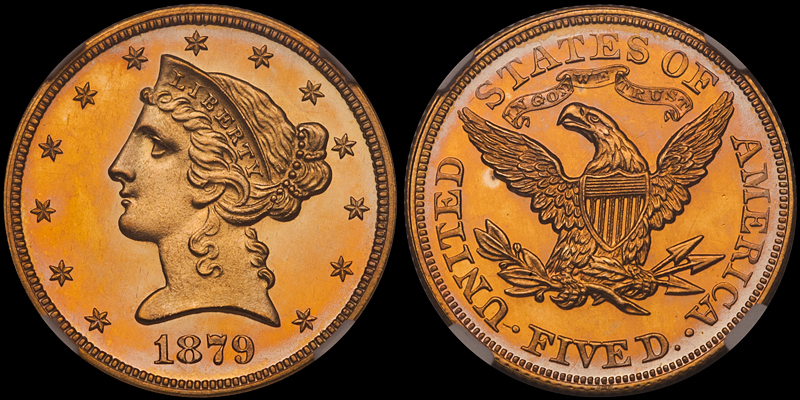
1879 $5.00 NGC PR64+ CAMEO
Proof gold remains one of the more complex areas of the upper-end coin market and it is important for the collector to work with a knowledgeable dealer to help navigate these choppy seas. When you collect Proof gold, your dealer should be able to assist you with the following:
Is the coin nice for the grade?
Has the coin been doctored (lots of Proof gold has)?
What sort of price premium do you pay for very rare, seldom-traded dates?
Is the price premium for a Deep Cameo/Ultra Cameo example justified?
Does the coin have a known pedigree?
Hopefully, you found this article interesting and it answered at least some of your questions. I know you have more and I would be happy to answer them for you and, perhaps, help you assemble a collection. Please contact me at [email protected] or phone me at (214) 675-9897.
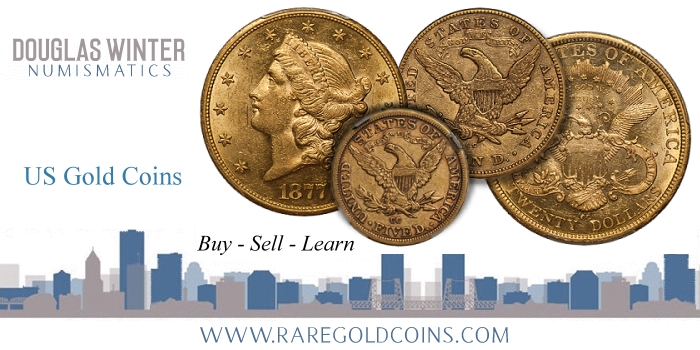
* * *
About Doug Winter
 Doug has spent much of his life in the field of numismatics; beginning collecting coins at the age of seven, and by the time he was 10 years old, buying and selling coins at conventions in the New York City area.
Doug has spent much of his life in the field of numismatics; beginning collecting coins at the age of seven, and by the time he was 10 years old, buying and selling coins at conventions in the New York City area.
In 1989, he founded Douglas Winter Numismatics, and his firm specializes in buying and selling choice and rare United States coins, especially US gold coins and all branch mint material.
Recognized as one of the leading specialized numismatic firms, Doug is an award-winning author of over a dozen numismatic books and the recognized expert on US Gold. His knowledge and an exceptional eye for properly graded and original coins has made him one of the most respected figures in the numismatic community and a sought after dealer by collectors and investors looking for professional personalized service, a select inventory of impeccable quality and fair and honest pricing. Doug is also a major buyer of all US coins and is always looking to purchase collections both large and small. He can be reached at (214) 675-9897.
Doug has been a contributor to the Guidebook of United States Coins (also known as the “Redbook”) since 1983, Walter Breen’s Encyclopedia of United States and Colonial Coins, Q. David Bowers’ Encyclopedia of United States Silver Dollars and Andrew Pollock’s United States Pattern and Related Issues
In addition, he has authored 13 books on US Gold coins including:
- Gold Coins of the New Orleans Mint: 1839-1909
- Gold Coins of the Carson City Mint: 1870 – 1893
- Gold Coins of the Charlotte Mint: 1838-1861
- Gold Coins of the Dahlonega Mint 1838-1861
- The United States $3 Gold Pieces 1854-1889
- Carson City Gold Coinage 1870-1893: A Rarity and Condition Census Update
- An Insider’s Guide to Collecting Type One Double Eagles
- The Connoisseur’s Guide to United States Gold Coins
- A Collector’s Guide To Indian Head Quarter Eagles
- The Acadiana Collection of New Orleans Coinage
- Type Three Double Eagles, 1877-1907: A Numismatic History and Analysis
- Gold Coins of the Dahlonega Mint, 1838-1861: A Numismatic History and Analysis
- Type Two Double Eagles, 1866-1876: A Numismatic History and Analysis
Finally, Doug is a member of virtually every major numismatic organization, professional trade group and major coin association in the US.




